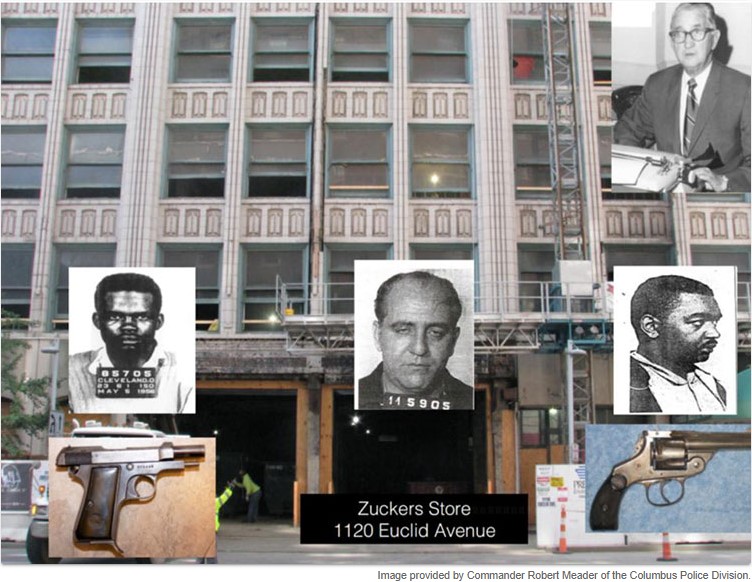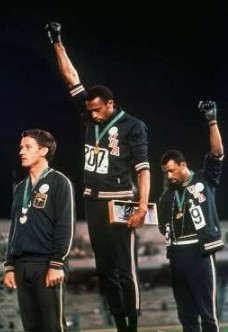America in 1968: The Music and Society that Shaped Terry V. Ohio
Nora M. Cronin, JD
Issues/Topics Covered in this Chapter
- Understand the social and political landscape of the United States in the 1960s.
- Describe who the parties were and their backgrounds in Terry v. Ohio.
- Evaluate how social movements affect public policy
Terry v. Ohio, a landmark case that was decided by the Supreme Court in 1968, arose out of what may have been a routine arrest by Cleveland Police Detective, Martin J. McFadden of three people, one of whom included John Terry.

Newspaper Report: Illegal Search is Charged at Concealed Weapons Trial 09/22/1964
This newspaper reports that Defense Attorney Louis Stokes asked Common Pleas Court Judge Bernard Friedman to dismiss the concealed carry charges against John Terry and Richard Chilton on the grounds that Cleveland PD Detective Martin McFadden’s search of the two men was illegal and violated their constitutional rights under the Fourth Amendment.[1]
When John Terry decided to argue that the state of Ohio had violated his constitutional right under the 4th Amendment to be free from illegal searches and seizures, he did not do so in a vacuum. The 1960s was a time of great social change in the United States, where Americans began thinking differently about society and their place in it.
Despite the relatively progressive nature of the 1960s, the Supreme Court decided 8-1 in favor of the state of Ohio in this case when it said that Detective McFadden’s search and pat down of John Terry on Euclid Avenue on October 31, 1963, was legal.
Regardless of the permissive social attitudes of the time, the Supreme Court’s 8-1 decision reflected “a shift in national attitude. … [it] was a complete capitulation to law enforcement interests, reflecting the national mood dominated by a demand for ‘law and order.'”[2]Many people expected the Supreme Court to support law enforcement in this case, an assumption that may have reflected the increasing public sentiment that law enforcement was the only means to maintain law and order and prevent cities from falling into chaos.
In his dissent, Justice Douglas also noted the strong public pressure,[3]and in private correspondence, Justice Brennan also acknowledged similar pressure.[4]
Detective McFadden exemplified the professional policing the court wanted to endorse in this decision.
Officer McFadden testified that while he was patrolling in plain clothes in downtown Cleveland at approximately 2:30 in the afternoon of October 31, 1963, his attention was attracted by two men, Chilton and Terry, standing on the corner of Huron Road and Euclid Avenue. He had never seen the two men before, and he was unable to say precisely what first drew his eye to them. However, he testified that he had been a policeman for 39 years and a detective for 35 and that he had been assigned to patrol this vicinity of downtown Cleveland for shoplifters and pickpockets for 30 years. He explained that he had developed routine habits of observation over the years and that he would “stand and watch people or walk and watch people at many intervals of the day.” He added: “Now, in this case when I looked over they didn’t look right to me at the time.”[5]
Above, the court takes time to describe Detective McFadden’s prior experience and patrol routine in great detail. The court also describes the pattern of observation he followed in this case, again in great detail.
Without Detective Martin McFadden, this case could likely have gone another way.
Cleveland State University has compiled a collection of documents related to Terry v. Ohio.
- Court Documents
- Cuyahoga County Court of Common Pleas
- Eighth Judicial District of Ohio, Court of Appeals, Cuyahoga County
- Ohio Supreme Court
- United States Supreme Court
- Journal Articles
- Newspaper Coverage
Browse the collection here.
In 1963, when John Terry was arrested, Cleveland was a city of 1,840,000 people, with a growing population that would continue to increase, reaching a peak population of almost 2 million in 1970, before a rapid population decrease of nearly 300,000 people by 1990.[6] The arrest took place at 1120 Euclid Avenue in East Cleveland which is historically more urbanized with a higher percentage of Black residents compared to the suburban environment and relatively white population of West Cleveland.

Music, Society, and Cultural
In 1964, urban unrest and riots began to surface in Harlem, New York City, and in 1965, in Watts, Los Angeles. These events alarmed residents. The unrest, motivated by allegations of racism, was serious and addressed by Martin Luther King, Jr. Additionally, music and culture at the time began to reflect unrest. Jimi Hendrix’s version of Bob Dylan’s “All Along the Watchtower” is just one example of the artistic expression of 1968. Compare this with a Billboard top song of 1963, “He’s So Fine” by the Chiffons, and contemplate how much the change in music reflects the change in society!
Of course, the Terry V. Ohio decision did not represent the end of the cultural movements taking place in 1968. One such example of defiance came that same year in October during the 1968 Summer Olympics in Mexico City, where two Black athletes, Tommie Smith and John Carlos, each ascended the podium and raised black-gloved fists in protest during the playing of the Star-Spangled Banner.

Discover additional social events contemporaneous with Terry v. Ohio (1968) in this supplementary chapter.
In the decades since Terry v Ohio, legal scholars have continued to discuss the case’s impact on contemporary law and police techniques, especially stop and frisk. Similarly, musical artists, particularly in the genre of Hip Hop, have used their lyrics to comment on many social and ethical questions related to law enforcement.
The challenge of balancing the interests of public safety with the respect for the rights of all Americans continues. The question of whether we have progressed or regressed in terms of this balance is up to you to decide.
Review Questions
- Describe the political and social conditions of the United States in the 1960s. How did the country shift from the early to late part of the decade?
- Can you compare current political and social conditions to those of the 1960s?
- What cultural and artistic milestones would you include to describe the 2020s era?
About the author: Nora M. Cronin, JD is a teaching faculty member with the International Criminal Justice Program at John Jay College.
- Cleveland Press, "64/09/22 Illegal Search is Charged at Concealed Weapons Trial" (1964). Newspaper Coverage. 6. https://engagedscholarship.csuohio.edu/terryvohio_newspaper/6 ↵
- Segal, J. (2012). " All of the Mysticism of Police Expertise": Legalizing Stop-and-Frisk in New York, 1961-1968. Harv. CR-CLL Rev., 47, 573 ↵
- Luna, E. (2008). Hydraulic Pressures and Slight Deviations. Cato Sup. Ct. Rev., 133. https://www.cato.org/supreme-court-review/2008-2009/hydraulic-pressures-slight-deviations ↵
- Barrett, J. Q. (1998). Deciding the Stop and Frisk Cases: A Look Inside the Supreme Court's Conference. . John's L. Rev., 72, 749. https://heinonline.org/HOL/P?h=hein.journals/stjohn72&i=761 ↵
- Terry v. Ohio, 392 u. S. 1(1968). (n.d.). Justia Law. Retrieved June 21, 2024, from https://supreme.justia.com/cases/federal/us/392/1/ ↵
- Cleveland metro area population 1950-2024. (n.d.). Retrieved June 21, 2024, from https://www.macrotrends.net/global-metrics/cities/22959/cleveland/population ↵
